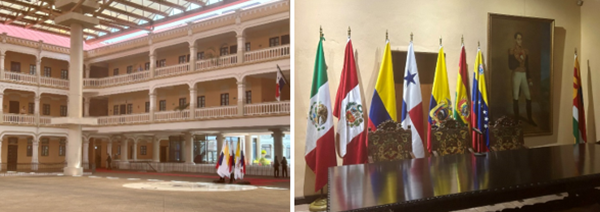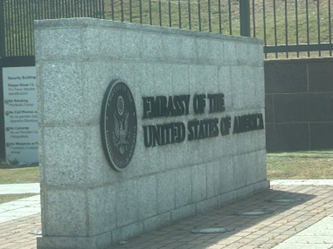Day 3 – Presidential Palace, Ministry of Foreign Affairs, U.S. Embassy
Palacio de Las Garzas – Presidential Palace
We could walk from our hotel in Casco Viejo to the Palacio de Las Garzas, which is the official residence of the President of Panama. It was named after resident African herons, which were brought as a gift in 1922 following final renovations of the palace under President Belisario Porras.
Here we learned of the palace and its history, and of the role of the executive branch of Panamanian Parliament. We were fortunate to have a top official show us the beautiful diplomatic rooms of the Palace.
Ministry of Foreign Relations
Later at Palacio Bolivar, home of the Ministry of Foreign Relations or MINREX, we heard Panamanian perspectives on U.S.-Panamanian relations currently and in the past, as well as their importance. The Palacio Bolivar, its namesake being Simon Bolivar, is located in the city center. The building is much like the others around it — colonial architecture, with arched windows and large arched entry points with sconces — and cobblestone streets all around.

Panama Canal Engineering Lecture
Then we headed to lunch at the JW Marriott in New Town Panama City, away from the canal and colonial influences of the old quarter, where one sees the modern architecture of skyscrapers, and shopping centers. It is then you see the true impact of having such an important avenue of trade. While this area is more of a modern urban revival, it also still houses older and historical buildings; however, the entry of modern infrastructure has taken its hold. This part of the city has much of the business, finance, and innovation hot spots of Panama City.
At Vespa – La Vespa Ristorante Vista Mare we heard from the retired Panama Canal engineer who oversaw the recent expansion. He discussed the bidding process, the construction and the environmental challenges and impacts faced by the original canal — as well as the expansion, highlighting climate change and the current drought.
The Panama Canal Authority (ACP) has been weighing “long-term solutions” to bolster the resilience of its key shipping route following last year’s El Niño-induced drought, which saw a reduction in daily transits.
A new reservoir at the Panama Canal to improve reliability could be ready within four to five years of construction, but there are regulatory and social hurdles to overcome first.
Briefing at U.S. Embassy
 The U.S Embassy is located just outside the Metropolitan Natural Park. It is a large square building with the front portion having all white slabs, and the back adjacent structure a light sandstone, also using geometric architecture with smaller squares on upper floors.
The U.S Embassy is located just outside the Metropolitan Natural Park. It is a large square building with the front portion having all white slabs, and the back adjacent structure a light sandstone, also using geometric architecture with smaller squares on upper floors.
Here we learned more of the history of U.S.-Panama relations from the U.S perspective. Discussion topics ranged from data privacy to anti-corruption efforts, trade, and environmental justice. We heard from various sections of the Embassy, including Education, Agriculture, Commercial, Justice, and Political and Economic. The U.S.–Panama relationship is a good one on many fronts.
We concluded the evening with dinner in new Panama City among the skyscrapers at the Azahar Panama Restaurant.
 Blog By
Blog By
(Mrs.) Susanne Stirling
Vice President, International Affairs
susanne.stirling@calchamber.com
